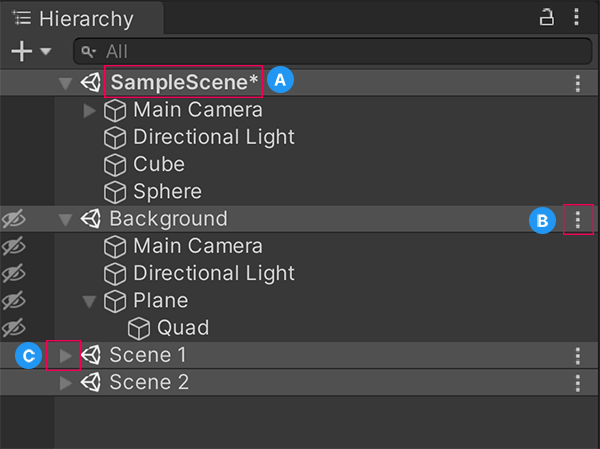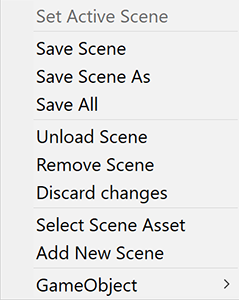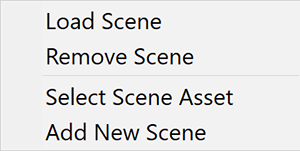Set up multiple scenes
You can add multiple scenes, edit how you view them, and change the sceneA Scene contains the environments and menus of your game. Think of each unique Scene file as a unique level. In each Scene, you place your environments, obstacles, and decorations, essentially designing and building your game in pieces. More info
See in Glossary settings.
To create a new scene, see Creating, loading, and saving Scenes.
Add scenes
To add a new scene to your project, do one of the following:
- Right click to open the menu of a scene asset in the Project windowA window that shows the contents of your
Assetsfolder (Project tab) More info
See in Glossary and select Open Scene Additive. - Drag one or more scenes from the Project window into the Hierarchy window.
View scenes
The Hierarchy window displays all the scenes that are part of your project:

A: Scenes with unsaved changes have an asterisk by the scene name.
B: The scene More menu allows you to perform actions on the scene.
C: The scene divider (an inverted triangle) lets you collapse a scene and hide its contents from the Hierarchy to better manage multiple scenes.
Tip: To add a scene to the Hierarchy window without loading it, press Alt (macOS: press Option) and drag the scene into the Hierarchy window. This lets you load the scene when it’s convenient for you.
Loaded scene More menu (⋮)
You can interact with and edit a loaded scene in several ways.

| Setting | Description |
|---|---|
| Set Active Scene | Sets the scene as the target for new GameObjectsThe fundamental object in Unity scenes, which can represent characters, props, scenery, cameras, waypoints, and more. A GameObject’s functionality is defined by the Components attached to it. More info See in Glossary created through scriptsA piece of code that allows you to create your own Components, trigger game events, modify Component properties over time and respond to user input in any way you like. Glossary created through scriptsA piece of code that allows you to create your own Components, trigger game events, modify Component properties over time and respond to user input in any way you like. More info See in Glossary. For more information, see SceneManager.SetActiveScene. |
| Save Scene | Saves the scene that you selected. |
| Save Scene As | Opens your file browser so you can choose where and how to save the scene. |
| Save All | Saves all the scenes you have open in the Hierarchy window. |
| Unload Scene | Hides the contents of the scene from the Scene viewAn interactive view into the world you are creating. You use the Scene View to select and position scenery, characters, cameras, lights, and all other types of Game Object. More info See in Glossary and the Hierarchy window. If you have unsaved changes, save them before you unload the scene to not lose any changes. |
| Remove Scene | Removes the scene from the Hierarchy window. |
| Discard changes | Undoes any changes that you haven’t saved. |
| Select Scene Asset | Highlights the scene asset in the Project window. |
| Add New Scene | Adds a new untitled scene below the scene you have selected. |
| GameObject | Opens a dropdown menu of GameObjects that you can add to the scene you have selected. |
Unloaded scene More menu (⋮)
You can interact with and edit an unloaded scene in fewer ways than you can a loaded scene.

| Setting | Description |
|---|---|
| Load Scene | Displays the contents of the scene in the Hierarchy window and the Scene view, and allows you to edit them. |
| Remove Scene | Removes the scene from the Hierarchy window. |
| Select Scene Asset | Highlights the scene asset in the Project window. |
| Add New Scene | Adds a new untitled scene below the scene you have selected. |
Multiple scenes in Play mode
When you are in Play mode and have multiple scenes in the Hierarchy window, the Editor displays an additional scene called DontDestroyOnLoad.
Scene-specific settings
The following settings are specific to each scene:
- RenderSettings and LightmapSettings (both found in the Lighting window).
- NavMeshA mesh that Unity generates to approximate the walkable areas and obstacles in your environment for path finding and AI-controlled navigation. NavMeshA mesh that Unity generates to approximate the walkable areas and obstacles in your environment for path finding and AI-controlled navigation. More info
See in Glossary settings. - Scene settings in the Occlusion CullingA process that disables rendering GameObjects that are hidden (occluded) from the view of the camera. Occlusion CullingA process that disables rendering GameObjects that are hidden (occluded) from the view of the camera. More info
See in Glossary window.
Each scene manages its own settings, so only settings associated with that scene save to the scene file.
To change the settings of a specific scene, either open that specific scene and change the settings, or set the scene as the active scene then change the settings. Otherwise, if you have multiple scenes open, Unity uses the rendering and NavMesh settings from the active scene.
When you switch to a new active scene in the Editor or at runtime, Unity replaces all previous settings with the settings from the new active scene.